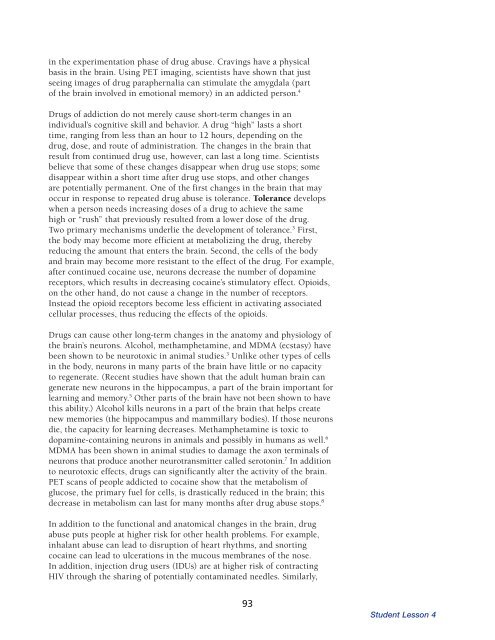Drug Abuse And Addiction - NIH Office of Science Education
Drug Abuse And Addiction - NIH Office of Science Education
Drug Abuse And Addiction - NIH Office of Science Education
Create successful ePaper yourself
Turn your PDF publications into a flip-book with our unique Google optimized e-Paper software.
in the experimentation phase <strong>of</strong> drug abuse. Cravings have a physicalbasis in the brain. Using PET imaging, scientists have shown that justseeing images <strong>of</strong> drug paraphernalia can stimulate the amygdala (part<strong>of</strong> the brain involved in emotional memory) in an addicted person. 4<strong>Drug</strong>s <strong>of</strong> addiction do not merely cause short-term changes in anindividual’s cognitive skill and behavior. A drug “high” lasts a shorttime, ranging from less than an hour to 12 hours, depending on thedrug, dose, and route <strong>of</strong> administration. The changes in the brain thatresult from continued drug use, however, can last a long time. Scientistsbelieve that some <strong>of</strong> these changes disappear when drug use stops; somedisappear within a short time after drug use stops, and other changesare potentially permanent. One <strong>of</strong> the first changes in the brain that mayoccur in response to repeated drug abuse is tolerance. Tolerance developswhen a person needs increasing doses <strong>of</strong> a drug to achieve the samehigh or “rush” that previously resulted from a lower dose <strong>of</strong> the drug.Two primary mechanisms underlie the development <strong>of</strong> tolerance. 3 First,the body may become more efficient at metabolizing the drug, therebyreducing the amount that enters the brain. Second, the cells <strong>of</strong> the bodyand brain may become more resistant to the effect <strong>of</strong> the drug. For example,after continued cocaine use, neurons decrease the number <strong>of</strong> dopaminereceptors, which results in decreasing cocaine’s stimu latory effect. Opioids,on the other hand, do not cause a change in the number <strong>of</strong> receptors.Instead the opioid receptors become less efficient in activating associatedcellular processes, thus reducing the effects <strong>of</strong> the opioids.<strong>Drug</strong>s can cause other long-term changes in the anatomy and physiology <strong>of</strong>the brain’s neurons. Alcohol, methamphetamine, and MDMA (ecstasy) havebeen shown to be neurotoxic in animal studies. 3 Unlike other types <strong>of</strong> cellsin the body, neurons in many parts <strong>of</strong> the brain have little or no capacityto regenerate. (Recent studies have shown that the adult human brain cangenerate new neurons in the hippocampus, a part <strong>of</strong> the brain important forlearning and memory. 5 Other parts <strong>of</strong> the brain have not been shown to havethis ability.) Alcohol kills neurons in a part <strong>of</strong> the brain that helps createnew memories (the hippocampus and mammillary bodies). If those neuronsdie, the capacity for learning decreases. Methamphetamine is toxic todopamine-containing neurons in animals and possibly in humans as well. 6MDMA has been shown in animal studies to damage the axon terminals <strong>of</strong>neurons that produce another neurotransmitter called serotonin. 7 In additionto neurotoxic effects, drugs can significantly alter the activity <strong>of</strong> the brain.PET scans <strong>of</strong> people addicted to cocaine show that the metabolism <strong>of</strong>glucose, the primary fuel for cells, is drastically reduced in the brain; thisdecrease in metabolism can last for many months after drug abuse stops. 8In addition to the functional and anatomical changes in the brain, drugabuse puts people at higher risk for other health problems. For example,inhalant abuse can lead to disruption <strong>of</strong> heart rhythms, and snortingcocaine can lead to ulcerations in the mucous membranes <strong>of</strong> the nose.In addition, injection drug users (IDUs) are at higher risk <strong>of</strong> contractingHIV through the sharing <strong>of</strong> potentially contaminated needles. Similarly,93Student Lesson 4
















